| Columns Retired Columns & Blogs |
Thank you.
An instant classic review!!!
I used DRA Labs' MLSSA system, a calibrated DPA 4006 microphone, and an Earthworks microphone preamplifier to measure the Triangle Antal 40th's behavior in the farfield. I used an Earthworks QTC-40 microphone for the nearfield responses. This mike has a ¼"-diameter tip, so it will not obstruct the radiation from the driver diaphragms or port.
The Antal 40th's anechoic sensitivity is specified as a high 92dB/W/m. My B-weighted estimate was 3dB lower, at 89dB(B)/2.83V/m, though this is still higher than average. Triangle specifies the Antal 40th's impedance as 8 ohms, with a minimum magnitude of 3 ohms. Using Dayton Audio's DATS V2 system, I measured an impedance magnitude (fig.1, solid trace) that reached a minimum value of 2.5 ohms at 132Hz. Compounding the need for current from the partnering amplifier, the electrical phase angle (dotted trace) is occasionally high. As a result, the effective resistance, or EPDR (footnote 1), lies below 2 ohms between 66Hz and 145Hz and between 180Hz and 645Hz, and the minimum value is 1.11 ohms at 93Hz. While, to some extent, the drive difficulty will be ameliorated by the moderately high sensitivity, the Antal 40th will work best with amplifiers that don't have problems driving low impedances.
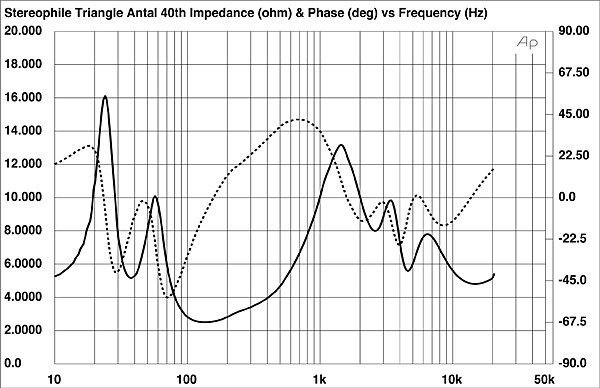
The traces in fig.1 are free from the slight discontinuities that would imply the presence of resonances of various kinds. However, when I investigated the enclosure's vibrational behavior with a plastic-tape accelerometer, I did find some resonant modes. Fig.2 is a waterfall plot calculated from the accelerometer's output when it was fastened to a sidewall level with the upper woofer. (This was the liveliest of the enclosure's panels when I rapped them with my knuckles.) Modes can be seen at 336Hz and 523Hz, both of which are relatively high in level. Their Q (Quality Factor) is high, which will work against audibility.
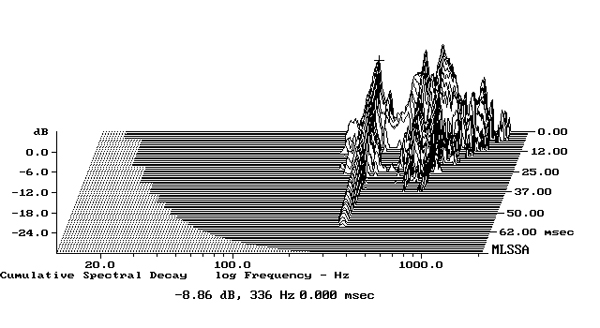
The saddle centered at 37Hz in the impedance magnitude trace indicates that this is the tuning frequency of the flared port at the bottom of the front baffle. The port's response, measured in the nearfield (fig.3, red trace), peaks at the tuning frequency. While the upper-frequency rolloff is disturbed by a small peak just below 200Hz, the rolloff is otherwise smooth and free from resonances in the midrange. The sum of the two woofers' nearfield outputs (blue trace; both woofers behave identically) has the expected minimum-motion notch at the port tuning frequency, which is when the back pressure from the port resonance holds the cones still. The woofers' response slopes down gently above 150Hz, with some overlap with the nearfield output of the midrange unit (green trace). The latter has a small peak at 200Hz.
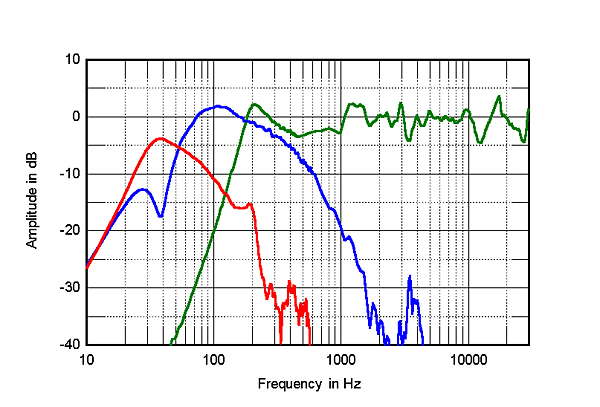
The complex sum of the Antal 40th's midrange, woofer, and port responses is shown as the black trace below 300Hz in fig.4. The peak at 200Hz will be due to the midrange unit's output, and there is no sign of the boosted midbass region typically seen as a result of the nearfield measurement technique. The Triangle speaker's low-frequency alignment is therefore overdamped, favoring articulation over ultimate bass weight.
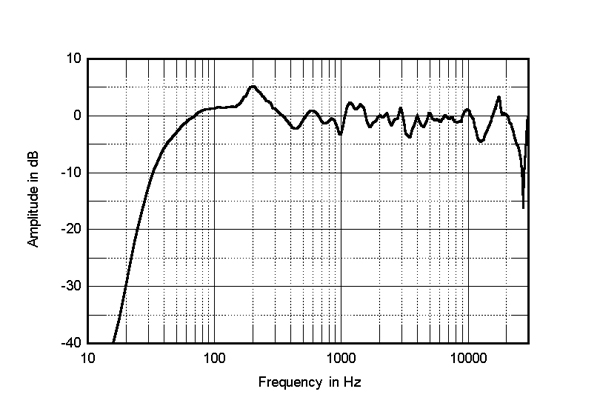
The black trace above 300Hz in fig.4 shows the Antal 40th's quasi-anechoic farfield response averaged across a 30° horizontal window centered on the tweeter axis. While the tonal balance is even from 300Hz to 10kHz, many small peaks and dips are present. The tweeter is 41" from the floor, which is 5" higher than what we have found to be the ear height of a typical listener. I queried RS about the height of his ears; he responded that sitting on his "somewhat saggy-cushioned sofa," his ears were level with the midrange unit. He noted that he didn't hear any change in tonal balance when he raised himself higher. I repeated the farfield response measurement on the midrange axis. It was identical to the tweeter-axis response in fig.4, confirming RS's observation.
Fig.5 shows the Antal 40th's horizontal dispersion, normalized to the response on the tweeter axis, which thus appears as a straight line. Other than some irregularities in the mid-treble region, the contour lines in this graph are evenly spaced, suggesting a steady, well-controlled narrowing of the speaker's radiation pattern as the frequency increases. The Triangle's dispersion in the vertical plane, shown in fig.6, confirms that the tweeter-axis response is maintained 5° below that axis. A suckout at 4kHz develops above the tweeter axis, which implies that this is the crossover frequency between the midrange unit and the tweeter.
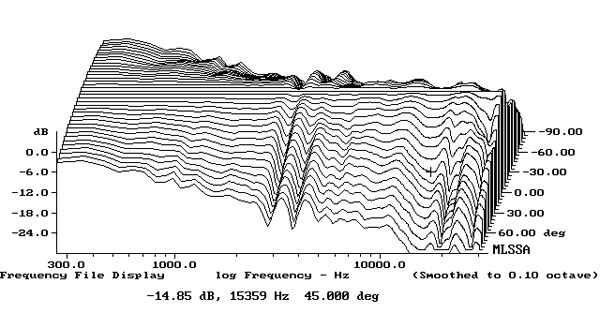
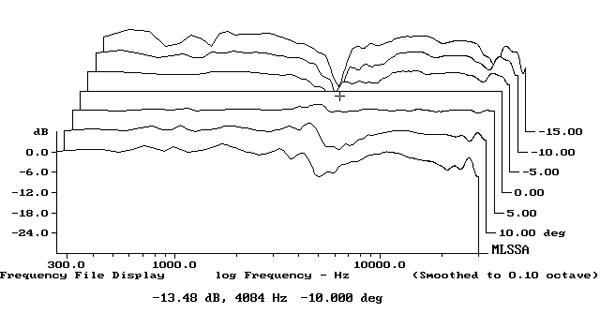
In the time domain, the Antal 40th's step response (fig.7) indicates that the tweeter and midrange unit are connected in negative polarity, the woofers in positive acoustic polarity. The tweeter's output arrives first at the microphone, followed by that of the midrange unit, then that of the woofers. The positive-going decay of the midrange unit's output smoothly blends with the positive-going start of the woofers' step, but the decay of the woofers' output is disturbed by some oscillations that correlate with ridges of delayed resonant energy in the speaker's cumulative spectral-decay plot (fig.8). The plot's decay is clean, however, in the region covered by the horn-loaded tweeter.
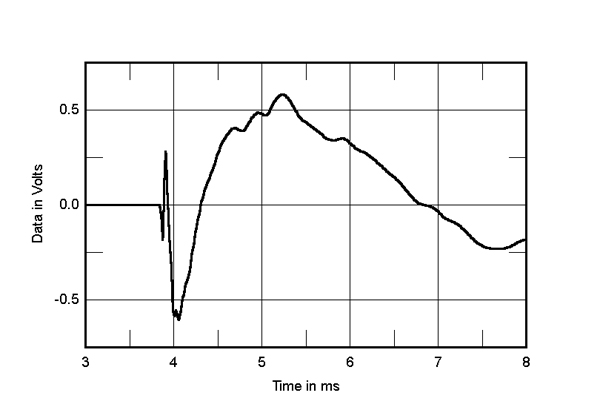

The Triangle Antal 40th's frequency balance is flat and even (footnote 2), its dispersion in both planes is well-managed, and the low frequencies are extended if overdamped. The presence of resonances in the region where hearing is most sensitive might be problematic, although their high Q will make them less audible. I could hear the effect of this behavior with the noiselike MLSSA signal, but it will be less audible with music, where it might be outweighed by the loudspeaker's positive attributes.—John Atkinson
Footnote 2: Though the Antal 40th's farfield frequency response has many small peaks and dips, my experience has been that these tend to balance each other when it comes to tonal balance perception.

Thank you.
An instant classic review!!!

that "breaks in" is the audiophiles brain. Opinions to the contrary are audiophile nonsense. But there's an aweful lot of audiophile nonsense about everything here so who am I to complain? Whatever you believe is true for you. A lot like religion. If something has no basis in fact then we're all free to believe whatever we decide. It's all good.

Your comments bring this place down. However, my new strategy is to ignore your opinions as I would the ravings of a mad man. Yes this is an ad hominem attack because to even debate what you are being a contrarian about is to stoop too low. A mind like yours cannot accept such abstract concepts. I'm surprised that you can even listen and understand music.

would you accept Klippel factor measurements vs break-in time as proof of brake-in affects? Spider material as much as rubber or whatever the material surrounding the cone measurably change their stiffness & damping properties, especially vs displacement, after having been worked back and forth a couple of (hundred or thousand) times. non-linear properties to plastics isn't really a new thing in science.
See literature on Klippel factors.
PS: it is considerably easier to claim & proof the existence of a particular effect than its universal absence.
best regards
hb72

to get addictive it is necessary that the sound meets the "expectation" you expect from the sound of your hi-fi.

there was someone quite famous in this business who said along the line of , " if you can hear it and it can't be measured than we are measuring the wrong thing." We are all stupid for believing and hearing that audio equipment breaks in but you guys in the white lab coats on audio science review know better than us fools. If that's true, don't go to stereophile to comment just like I dont comment on the audio science review. Keep your opinions to yourself and let us deluded fools us enjoy Stereophile and let us waste our money how we want.

...verges on projection. It wants for traceability and falsifiability, and it contradicts reams of cross-linked, patternable user evidence. It gatekeeps for X what Y may hear. At its best the theory of habituation relies on disconnected assumption and at its worse it abuses and impairs the audio high end.
Together with the myth that things may not break in because reasons, it's another failure of pseudo-reductionism, in this case back down to average sound.
In no field is a phenomenon adamantly disallowed for you until I can prove it to my satisfaction. Just here.

Haven't we heard all these arguments from both sides before? They each fail to convince the other side.
I prefer to take each review at face value, including issues such as this, that inform us of the author's perspective and interpret it in the context of my own perspective rather than throwing out the baby with the bath water.

Funny story happened to me a few weeks ago regarding product habituation. A chap was selling a pair of Linn Kan stands and a recently refurbished pair of Linn Kan I’s. I got the stands and then wondered about buying the Kan I’s. Owning a pair of IIs, I thought it would be fun to do a side-by-side, but I thought better of it than spend $500 on a whim. A week later, he had reduced the price to $350 and told me that Linn purchasers were picky and didn’t want them because he had re-veneered the wood and wasn’t stock looking anymore. He offered to send them to me on his dime and compare them with mine and if I liked them, I could pay him after. When I finally compared them to my II’s I was stunned; mine sounded lifeless; I put my ear to the tweeters to ensure they were working. I checked with companies in the UK, including Falcon Acoustics, about what would cause this, and they think the caps in the crossover were toast. But I realized I was listening to these speakers the last few years, thinking everything was fine when they were slowly declining as performers. The I’s with the new caps, new Falcon Acoustics woofers, and new Hiquaphone tweeters were clearer, more detailed than my ten years younger IIs. Amazing what tricks my brain played on me, always knew I didn’t have golden ears. Time to recap and bring those II’s to full spec.

A room acoustics friend of mine said that the sound of our gear invariably changes due to the constant flow of current running through the components. It's a process that results in altering frequencies and shifting phases, some of which our brain adapts to, some of which it doesn't, and all of which renders the overall sound less involving to us over time.
If it's true, it's a good argument for new or refurbished gear.

If it's true. Does your friend have a reference to any study or investigation of this?

Actually, at this time, to answer your question, Kal, he "more likely does".
This friend works in the industrial acoustic treatment field, mostly to do with soundproofing and lowering room reverberations. He also has his own acoustic treatment business that caters to audiophiles. He mentioned the above theory — those shifting tonalities, frequencies, phases — as being one of the prime reasons why audiophiles, particularly those who never cared about room acoustics before, are now looking for a way to regain their diminished enthusiasm for their system's sound.
And it appears that acoustic treatment can work to this end, because it's designed to compensate for acoustic imbalances. That doesn't mean, however, that it might not be a better idea to just buy something new to replace the old.
I'm sure his work — his passion — is based on scientific evidence, but my gut tells me it's a plausible theory.
I'll ask him for a reference.

There was a guy in my Hi Fi Club who had a major league system, built around some "A" grade equipment.
When I first sat in his room, I thought he had found sonic paradise. Imaging, frequency response, everything.
It had that "live in the same room illusion."
It was perfect, until it started to dawn on me that while it certainly did have all those qualities, it was more like 'live in an eternally unchanging room.'
All the music had that great feeling, but every recording was placed into the same sonic room, over and over.
It wasn't doing anything wrong, but over time I came to dread hearing it.
Everyone's, even Jack L's, system sounds basically the same from day to day....habituation leads to some slight ennui which leads to changing gear. All systems fail that final test of live v recording. At first we may marvel at how close they come, but over time, we tire of hearing the same failure day after day, and we move on.
In general.
Sorry for drifting from the topic of breaking in gear. Breaking us in or breaking us down is also a big part of the hobby, for sure.

This is why I have 3 systems with different characters. A fleawatt SET with full-range open baffles. Then massive Maggies with tube pre and Class D amp. And then mini maggies with class A amp, for near field. Get a little tired of one, go to another.

I believe in your system,exactly.
I had a friend growing up who was like this when it came to dating: the initial rush, habituation, moving on.
Sometimes 'different' is actually what we perceive as 'better.'
Thanks for your great post!